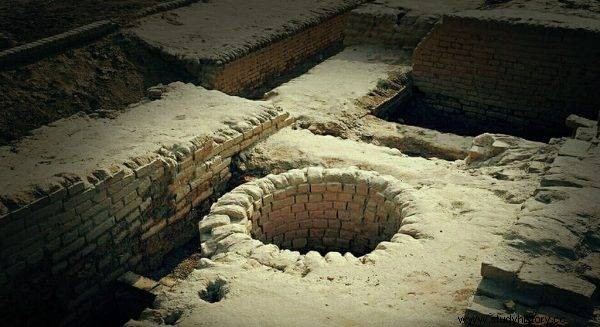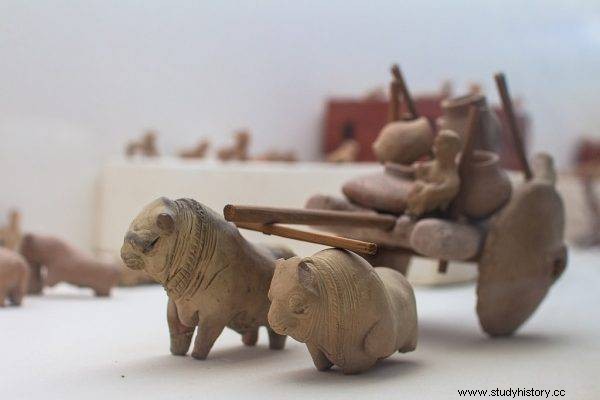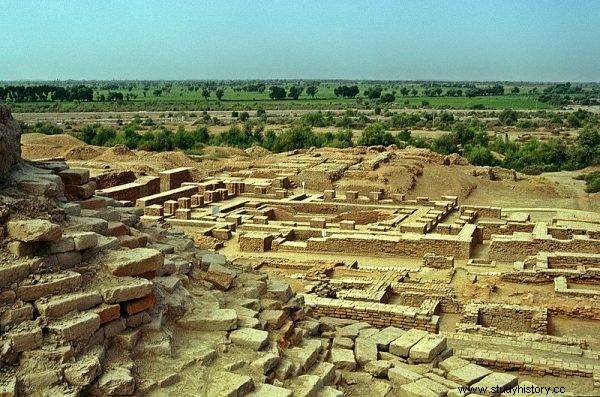Amazing cities grew up in the Indus Valley over 5,000 years ago. The people who created them drew even streets. The houses had access to sewage and fresh water - thanks to the system of huge pools, it was never lacking. Scientists are still wondering about the phenomenon of Mohenjo Daro culture. Who and why built ancient settlements? What did their inhabitants believe? Why did their culture collapse?
The culture of Mohenjo Daro - the Indus Valley civilization in today's Pakistan - is one of the oldest cultures in the world. It developed in parallel with the state of the pharaohs. It is possible that she was older than Egypt. Some of the radiocarbon studies indicate that the oldest settlements belonging to this culture may have developed as much as 8,000 BC.
In addition to age, this culture is also distinguished by a huge area, reaching up to 1.5 million square kilometers, which makes it the largest territorially among the four great ancient civilizations (apart from Mohenjo Daro - Sumer, Egypt and China).
Nevertheless, for a long time the modern world had no idea about its existence. It was not until 1921 that the first expedition headed by archaeologist John Marshall set off to present-day Pakistan. It was he who discovered the ruins of an ancient city that was given the name Mohenjo Daro, which means "the mound of the dead" in the local language.
Lords of Water
About 5,000 years ago, 5 large and over 30 smaller towns and hundreds of settlements and villages grew up in the then fertile Indus Valley. Like any early civilization of mankind, this one too drew its wealth from the life-giving river. The Indus watered the fields and provided water. The people of Mohenjo Daro's culture have turned out to be exceptionally talented in using his gifts . In this field, their achievements far outstripped that of the Egyptians or the Sumerians.
Around the city of Dholavira - one of the five largest centers of this civilization - the inhabitants created a system of several large reservoirs (over 70 meters long and about 7 meters deep for each), which distributed and cleansed the water from tides. The life-giving fluid enriched in this way was delivered to the municipal water supply. All year round, these people had clean water in their own homes, while a network of irrigation canals irrigated the surrounding gardens, orchards and fields, ensuring bountiful crops. In short - they lived in constant well-being.
Researchers are also amazed at their unique planning skills. The largest - main cities of this civilization - Mohenjo Daro and Harappa - show surprisingly regular buildings.

All year round, these people had clean water in their own homes, while a network of irrigation channels irrigated the surrounding gardens, orchards and fields, yielding bountiful crops.
They were built of bricks with standardized dimensions. Both were divided into the upper city - with public utility buildings - and the lower city - with the houses of the inhabitants. In Mohenjo Daro, the upper town is situated on an artificial brick hill. It had separate fortifications. In the upper city, among others, the so-called great bathhouse. It was a multi-room complex, including eight bathrooms situated around the pool measuring 12 x 7 x 2.5 meters. Water was supplied to it from a brick well. Archaeologists have also distinguished a large hall with an area of 900 square meters, which was called the Assembly House, and the so-called Granary - likely grain storage location.
Under these buildings, people lived in the so-called lower town. The area of large housing "estates" is divided into equal rectangles with sides 1,200 by 800 feet (approximately 360 by 250 meters). The houses of the residents stretched along quite wide, 10-meter long promenades.
About 40,000 people could live in Mohenjo Daro at its peak. The houses of the "Mohammedans" usually had two storeys. They differed in the number of rooms, which may indicate a different social and economic status of people living in them.
The vast majority of them had their own water intake and were also connected to the sewage system. Thousands of years ago, these people had their own bathrooms and toilets. For comparison - the water supply and sewage system did not appear in Warsaw until the end of the 19th century.
Inside the houses of the inhabitants of the Indus Valley civilization there was a square patio with wells. In Harappa - the second largest center of this culture after Mohenjo Daro - ponds and 80 public toilets could also be found throughout the entire, precisely planned city with a grid of streets intersecting at right angles and diverging evenly from 9 meters wide thoroughfares. On the main streets there were, among others, water supply tanks and collectors, as well as for sewage disposal.
A land of peace?
To this day, archaeologists are wondering about unusual finds in Mohenjo Daro. Even a mass of objects resembling ... toys were discovered there. Among them were dice, such as the present ones, pieces resembling those from the popular "Chinaman", whistles, thousands of toy "men". There were also movable figures - clay carts drawn by oxen, animals with movable limbs. This prompts scientists to perceive residents as having fun, especially the youngest citizens.
In addition to toys, researchers found, among others ceramics, utensils, tools, a large number of seals with images of animals and people - probably used for commercial purposes. Beautiful jewelry was also found, as well as tablets with unreadable script.

Archaeologists are still wondering about the unusual finds in Mohenjo Daro. Even a mass of objects resembling… toys were discovered there.
However, most puzzlingly, researchers have so far not come across such a typical element of ancient cultures as weapons! They did not come across arrowheads, spears, swords, shields or clubs, and in the various paintings, seal motifs and human images there are no figures that could be considered warriors.
So does this mean that there was no army or other military force in Mohenjo Daro and other cities of this culture? This thesis is still under research. Some scientists believe that perhaps the representatives of this culture did not need an army. Perhaps, due to the lack of "natural" enemies in the area, military force was not needed?
Power without "ego"?
Surprisingly, while it is believed that the Harappians and Mohenjo Daro residents lived in a social hierarchy (with the ruling class at the top, etc.), the typical elements of power dominance are lacking. In ancient Egypt, the pharaohs built themselves magnificent palaces, obelisks, tombs, and mighty temples. In the cities of the Indus Valley, this type of structure cannot be seen.
Scientists have a problem with selecting buildings that could be considered, for example, the palace of rulers. Hence the interesting hypothesis that perhaps thousands of years ago there was a regime similar to the republican one …

Scientists have a problem with selecting buildings that could be considered, for example, the palace of rulers. Hence the interesting hypothesis that perhaps thousands of years ago there was a regime similar to the republican one ...
Little is known about what the people of Mohenjo Daro and other cities of this civilization really believed. The buildings that could serve as temples have not been identified with certainty. From the modest number of artifacts labeled as religious, it may appear that Harappians worshiped the Mother Goddess - a female deity of fertility and fertility. Ritual baths were also a probable habit.
However, these are only hypotheses. Almost nothing is known about the religiosity of these people.
Handwriting unreadable
Around the middle of the 2nd millennium BC. Mohenjo Daro culture has collapsed. The cities were abandoned by the inhabitants. Why? According to one of the hypotheses , the collapse of that world was caused by a war unknown to these people. They were to be attacked by the people of the Aryans who, with their arrival from the Iranian region, initiated the Indian culture. The problem is that no traces of invasion, fighting and population exchange have been found.
Several other scenarios are currently being adopted that may have led to the ancient paradise ceasing to exist. Perhaps it was due to climate change, the drying up of rivers and the desertification of the area . Another version says that the ancient, ideal world collapsed due to the degeneration of the inhabitants themselves. Overpopulation of cities, the collapse of morals and the authority of the aristocracy - all this could have resulted in a regression of civilization - replacing advanced forms of work and social life with simpler forms. Eventually, the former powerful cities were abandoned, and in place of the Indus culture, Vedic culture began to develop from new centers.
The secret of Mohenjo Daro would certainly help to solve the reading of the scriptures used by these people. So far, no one has succeeded in this art, and research into the language of this culture has not assigned it to any of the known language families. The problem is that no artifact similar to the Egyptian Rosetta Stone that helped to read the hieroglyphs was discovered thanks to its inscriptions in another known ancient language, Greek.
Language will be the gateway to knowing and understanding their world. Hopefully it will open soon and we'll learn more about this fascinating civilization.
Bibliography:
- Wheeler: The Indus Civilization:Supplementary Volume to the Cambridge History of India . Cambridge:Cambridge University Press, 1968.
- John Julius Norwich: The greatest cities in the history of the world . Ed. I. Olszanica:Bosz Publishing House, 2009.
- Collective work, 2005, Great World History - Asian Civilizations - Indus Valley - India - Cambodia , vol. 5, Polskie Media Amer.
Internet:
- http://www.ancientindia.co.uk/indus/index.html
- http://www.archaeologyonline.net/artifacts/harappa-mohenjodaro.html
